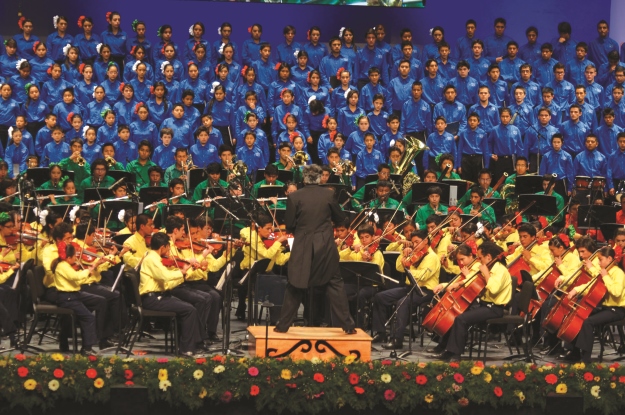This article is adapted from AQ’s special issue on the U.S.-Mexico relationship. To receive AQ at home, subscribe here.
Just a few days after Donald Trump’s inauguration on January 20, hundreds of young musicians from the United States and Mexico performed Verdi’s “Triumphal March” from Aida to audiences on both sides of the border. It wasn’t meant as political commentary , but rather as a showcase for the newly formed U.S./Mexico Youth Philharmonic Orchestra, a collaboration between the El Paso Youth Symphony and Esperanza Azteca Youth Orchestra/Ciudad Juárez. The combined orchestra was established in 2016 to promote cross-border musical partnership — as well as the rich musical heritage of both countries. To underscore that point, the group also performed George Gershwin’s “Rhapsody in Blue” and Mexican composer Samuel Zyman’s “Canto a la Música.”
Both orchestras have long been committed to instilling a love of classical music in young people. The El Paso Symphony Orchestra (EPSO), established in the 1930s, is the longest continuously running symphony orchestra in the state of Texas.
Its most recent transformation into a vehicle for music education was inspired by a Venezuelan program for children from low-income families called El Sistema, which EPSO executive director Ruth Ellen Jacobson learned about after seeing a story about it on TV. In September 2013, EPSO launched an after-school program called Tocando Music, based on the Venezuelan model. EPSO’s youth orchestra, led by musical director Dr. James O. Welsch, today includes 300 musicians.
EPSO’s work with young musicians found a perfect parallel in Esperanza Azteca Youth Orchestra (EA), which similarly took its inspiration from El Sistema. Founded by Mexican businessman Ricardo Salinas and the nonprofit Fundación Azteca, the orchestra began in the Mexican city of Puebla with 275 students in 2009. Today, the program includes over 17,000 participants in 87 student orchestras, including the chapter in Juárez. Most of the young people involved in the program have no musical background when they join the orchestra.
The collaboration between EA Juárez and the El Paso Symphony Orchestra has gone far beyond the enhancement of music education for low-income students. As Salinas said ahead of that debut concert on the border, “This is a good investment because these young men and women will become much better citizens. This is what we need, not only in America, but in the whole world … citizens that know how to work together.”
—
Cargo is a freelance musician and assistant to the director of the music program at the Americas Society




